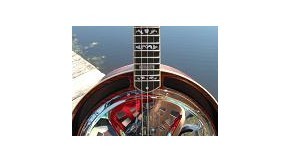Learning How to Play, Tune and Set up a Resophonic Banjo or "Dojo"
How to Play, Tune and Set up a Resophonic Banjo or "Dojo"
Here are some Resophonic Banjo Tips on strings to use, some alternate tunings that work well and other insights into transitioning from a normal bluegrass banjo using 3 finger Scruggs style Technique.
Resophonic banjos over the years have been called, Dobjos, Dojos, Resophonic Banjos, Resonator Banjos and a ResNick
I like to tune a resophonic banjo down to open E or Open F so I need the heavier strings to keep the tension with the lower tuning.
I recommend bringing it down to OPEN F or OPEN E, but to do that you will have to change the strings. Open E if you have not done it just lowers ALL strings one step and a half, and Open F lowers all strings one whole step. If you don't have heavier strings handy when you get the instrument Open F might be ok to experiment with before you use heavier string gauges. However normal banjo strings will be pretty slack in the lower tunings and feel loose, and the instrument will sound much better with the slightly heavier gauge strings. The recommend string gauges for these tunings are not super heavy by guitar player standards, its just that normal banjo strings are light gauge in comparison.
I put the notes you tune to for these tunings down below. Its very easy even if you have not done if before. The tunings don't require you to "relearn the banjo". You play everything the same way you do in open G, using the same techniques and playing the songs you know the same way. That is because each string is lowered the same distance, so only the key has changed not the relative distance between the notes. Its like using a reverse capo, taking everything down two frets to F for instance, rather than capoing up two frets to A.
I think you will really like the sound down there in the lower tunings, I know I do. The video I have below demonstrates that. The song I play Don't this Road Look Rough and Rocky, onthe Resnick Resophonic Banjo is tuned to Open E.
Something you might try on the Dojo that I have experimented with in addition to using heavier strings is a wound 3rd string. The heavier strings put more pressure on the wood top which forces more sound out like an acoustic guitar and also can give you a thicker more full tone.
You can play in Open G by simply capoing up two frets when tuned to Open F or three frets when tuned to Open E
Open E Tuning
1st D down to B
2nd B down to G#
3rd G down to E
4th D down to B
5th G down to E
String Gauges could be anywhere from.
Open F Tuning
1st - D down to C
2nd - B down to A
3rd - G down to F
4th- D down to C
5th - G down to F
String Gauges to use for the lower tunings could be anywhere from.
1st - 012 to 013
2nd - 015 to 017
3rd - 20 to 24 wound
4th - 26 to 30 wound
5th - 012 to 013
If you stick to playing in G lighten those gauges up a hair so not to put too much pressure on the neck.
More Dojo Playing Tips and Details
On Resophonic Banjos the structure is basically the same as a guitar, not a banjo so the dojo should not really be approached like playing a normal 5-string banjo. It's essentially a guitar with a 5-string neck on it and it accomplishes different things tonally and reacts differently when it's being played. Squaring that in your mind might put that it better musical perspective too. Playing a Resophonic Banjo is a new opportunity to make music using the same techniques as banjo but with more sustain and a different tamber. It will be fun to grow into utilizing these new tones to your musical advantage. Have fun with it. I think you will!
Tone Differences between a 5-string banjo and a Dojo,
Because the Dojo is basically a guitar with a dobro cone and a 5-string neck like a banjo the strings one through 5 behave and react differently than they do on a bluegrass banjo.
The key really is adding the wound 3rd and not going too light on the 5th and 1st strings. The tone on Dojos is rich and full on the low strings, 3rd and 4th string, up the neck which is very different from a normal banjo. On a normal banjo the 1st string is very bright and loud and used in the forefront for volume and tone but on resophonic banjos, dojos if the the 1st or 5th string is too light of gauge it works against you, especially if you hit it too hard.
You can really dig in when picking the 3rd and 4th wound strings but the steel strings need a lighter touch and also the thicker gauge string to get a fat balanced tone. As I write this I realize the whole thing is flipped. On a normal banjo the 3rd and 4th once past the 7th fret need special care to get good tone and intonation. On the Resnick the higher on the neck you play on the 1st and 2nd strings the more focus you need on the amount of picking pressure and your fretting hand pressure pushing down to get the best tone and intonation.
I came on that by ear and just made adjustments based on what I liked the sound of but it does not hurt for me to give you a tip on that.
Bottom Line
It's Flipped! With a Dojo... Wahoo, you finally get rich fat tone up the neck on the 3rd and 4th strings, BUT, BEWARE, if you whack the first and 2nd strings hard and over squeeze them when you fret, you are in for tone that you probably won't recognize or even care for. So lighten up and let the instrument dictate how its played. Play to the instruments strength. Remember, its not a banjo, it's just tuned like one. Then you can make it vibrate and sing out with it's own voice.
Hope that is helpful, Thanks, Ross
Sincerely, Ross Nickerson
https://banjoteacher.com
http:/rossnickerson.com
1-866-322-6567









